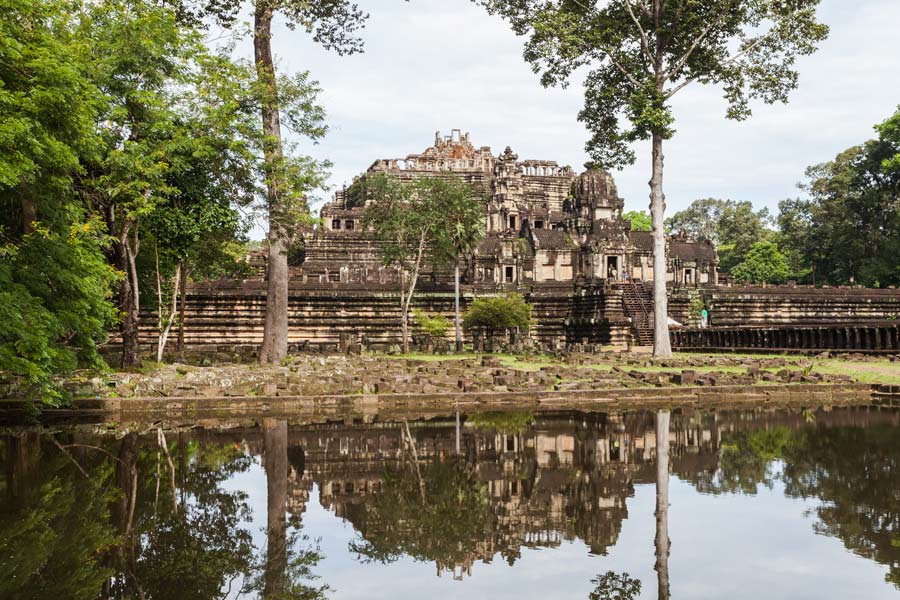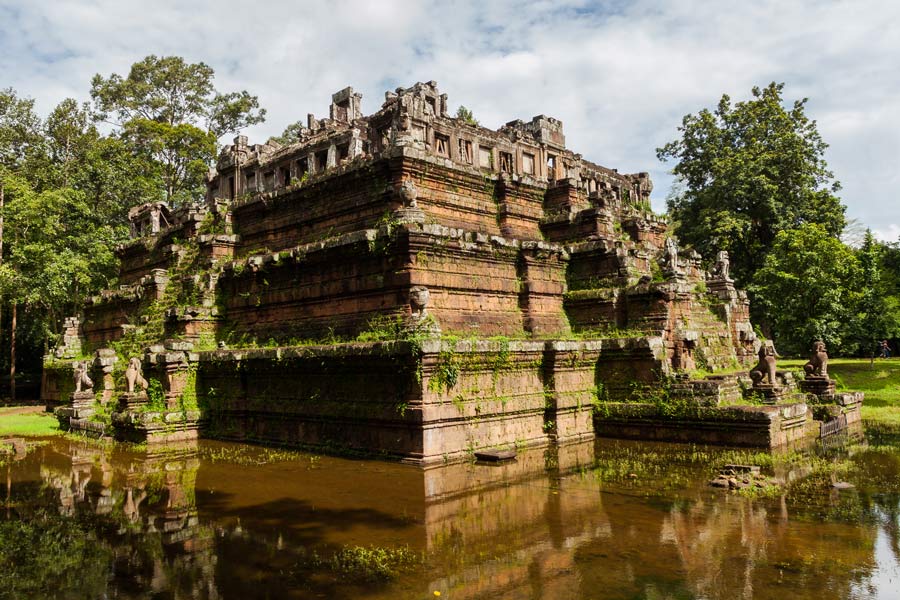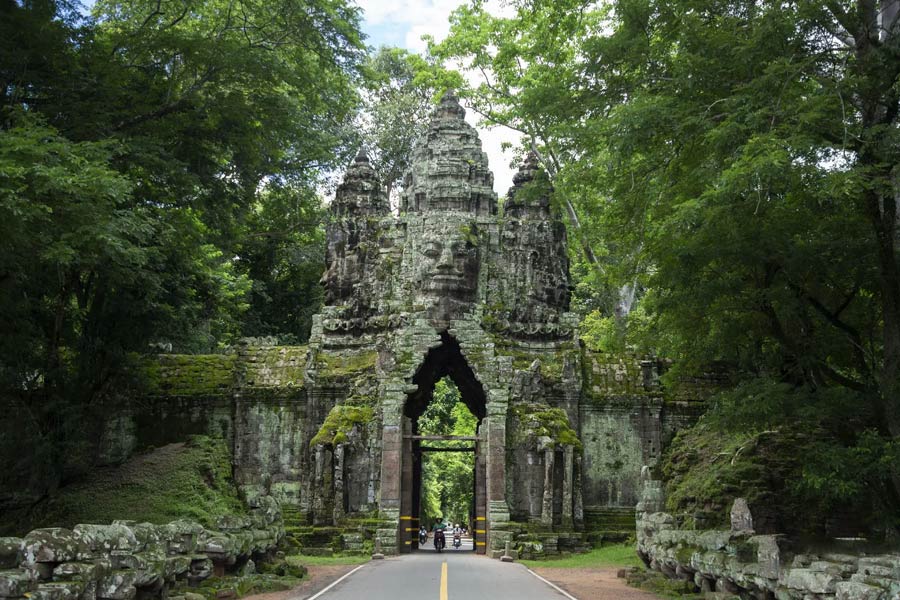Angkor Thom

Angkor Thom, the illustrious ancient city nestled near Siem Reap in Cambodia, stands as an enduring testament to the grandeur of the Khmer Empire. Commissioned by King Jayavarman VII in response to the Chams' sack of the previous capital, Angkor, this sprawling city emerged as the empire's final and most significant political, economic, and cultural hub from the late 12th century to the early 17th century. Enclosed by an expansive moat and a formidable laterite wall, Angkor Thom spans 9 square kilometers and boasts a meticulous design, featuring five monumental entrance gates adorned with captivating stone faces. Despite its eventual abandonment in the 17th century amid the Khmer Empire's decline, Angkor Thom remains an awe-inspiring UNESCO World Heritage Site, drawing millions of visitors yearly to marvel at its architectural splendor and unravel the historical legacy of Cambodia.
Angkor Thom's history is intricately intertwined with the rise and fall of the Khmer Empire, showcasing a saga of power, creativity, and eventual decline. Commissioned by King Jayavarman VII in the late 12th century as the Khmer capital, it emerged in response to the Chams' sacking of Angkor, the previous capital. The city's construction, marked by meticulous planning and remarkable architecture, embodied the king's ambition and resilience.
The city reached its zenith during the 13th century, serving as the pinnacle of Khmer power and prosperity. Its strategic layout, fortified by a moat and towering walls, reflected a commitment to defense and grandeur.
However, by the 17th century, the Khmer Empire faced a decline attributed to a combination of factors, including environmental changes, economic challenges, and political instability. As the empire waned, so did Angkor Thom, and the city was eventually abandoned.
Rediscovered by the French in the 19th century, Angkor Thom became a subject of fascination for archaeologists and historians. Its recognition as a UNESCO World Heritage Site in 1992 affirmed its global significance, drawing attention to its historical and cultural value. Today, Angkor Thom stands as a captivating archaeological marvel, inviting visitors to explore the remnants of a once-thriving empire and ponder the mysteries of its rise and fall. The enduring allure of Angkor Thom lies not only in its architectural splendor but also in the echoes of a bygone era that continue to resonate through its ancient stones.
Angkor Thom is home to several impressive and iconic attractions, showcasing the architectural and artistic achievements of the Khmer Empire.
Baphuon: This massive temple-mountain is dedicated to the Hindu god Shiva. It features a long causeway and a central tower, and it was constructed in the 11th century.

Baphuon once stood as one of the grandest temples in the Khmer Empire
Terrace of the Elephants: A long terrace adorned with intricate carvings of elephants, it served as a platform for public ceremonies and processions during the Khmer Empire.

The Terrace of the Elephants stands as a UNESCO World Heritage Site
Terrace of the Leper King: Adjacent to the Terrace of the Elephants, this terrace features a statue believed to depict the Hindu god Yama or a Khmer king. The terrace is named after a misinterpretation of the statue's appearance.

The Terrace of the Leper King is characterized by its intricate carvings
Phimeanakas: This pyramid temple is located within the Royal Enclosure and is associated with Hindu rituals. It provides a panoramic view of the surrounding area.

Phimeanakas is a style typical of Khmer architecture during the Angkor period
Preah Palilay: A small temple situated near the Terrace of the Elephants and the Royal Palace area, known for its distinctive cruciform terrace and central sanctuary.

Preah Palilay is a modest structure that dates back to the late 12th century
North Gate, South Gate, East Gate, West Gate, and Victory Gate: Angkor Thom is encircled by a wall and accessed through five monumental entrance gates, each featuring impressive stone faces and causeways lined with statues of gods and demons.

These gates carried symbolic and ritualistic significance of Angkor Thom
These attractions collectively offer a rich tapestry of Khmer architecture, art, and religious symbolism. Exploring Angkor Thom provides visitors with a deep appreciation for the historical and cultural significance of the Khmer Empire.
The cost of visiting Angkor Thom is included in the ticket you buy to visit the Angkor Wat complex.
Temple visiting hours: 05:00 a.m - 5:30 p.m
The best time to visit Angkor Thom and the wider Angkor Archaeological Park is during the dry season, which typically extends from November to March.
The most ideal time is from March to May of the following year. This is the peak tourist season in the land of pagodas, the weather is a bit hot and there are unique traditional festivals.
The months of November to February offer the most comfortable and visually appealing conditions for exploring Angkor Thom and the surrounding temples. However, visiting during the early part of the dry season or even the shoulder months of October and March can still provide a pleasant experience with fewer crowds compared to the peak months of December and January.
To reach Angkor Thom, visitors typically begin their journey in Siem Reap, the bustling town near the archaeological site. Siem Reap International Airport serves as the gateway for those arriving by air, with flights connecting to major cities in Asia. From the town center, approximately 15 to 20 minutes of travel by tuk-tuk or car brings visitors to the entrance of Angkor Thom. Tuk-tuks are a popular and affordable choice for transportation, offering a convenient means of exploration in and around Siem Reap. Alternatively, those arriving from Phnom Penh can take a bus or hire a taxi for the 6- to 7-hour journey. Once at Additionally, organized tours, bicycles for rent, and motorbike options cater to various preferences, offering flexibility for an immersive exploration of this captivating archaeological marvel